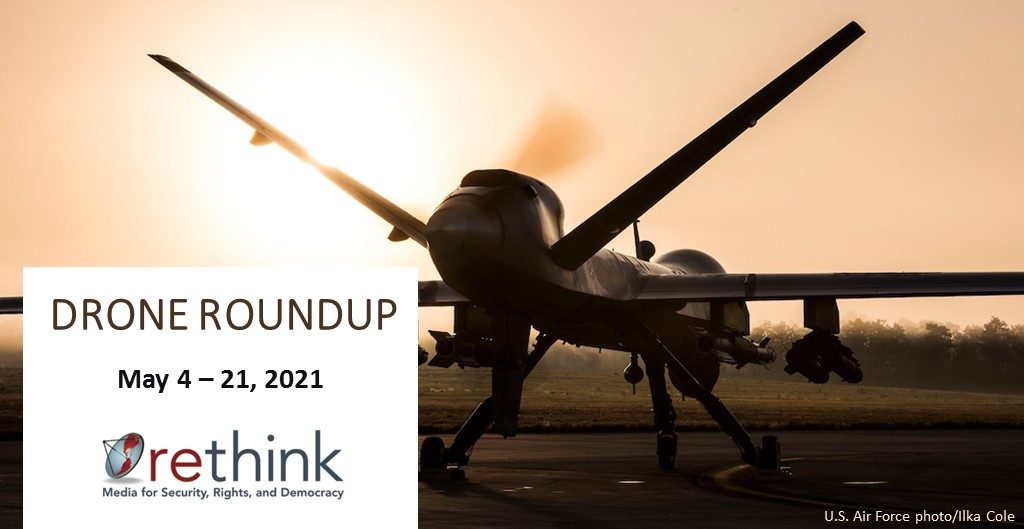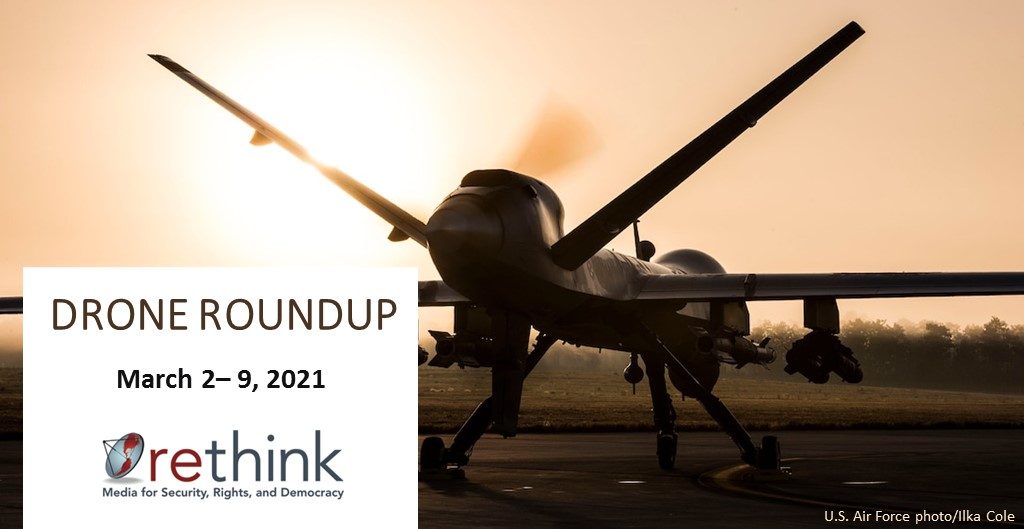At present, the United Kingdom (UK) has a drone fleet consisting of ten Reaper drones, and it is planning to replace the existing drone fleet with between twenty and twenty-six new Reaper drones (rebranded as ‘Protector’ drones) by 2021.
Data collected by the Stockholm International Peace Research Institute (Sipri) even suggests that the UK is one of the largest drone importers in the world having ordered three MQ-9 Reaper drones from the US and 55 ‘Watchkeeper’ drones from Israel since 2007.
In 2017 it was confirmed that an unknown number of the UK’s ten armed reaper drones were deployed to the Middle East as part of Operation Shader. In Iraq and Syria, Reapers have launched 29% of the UK’s strikes and 67% of the 110 UK’s strikes at ISIS fighters between 2017 and 2019. In 2020, the Ministry of Defence revealed that the Reapers have been deployed outside Operation Shader as well. The Ministry of Defence has however refused to share where and how often the Reapers have been deployed outside of the mission.
In August 2015 it became publicly knowledge that Britain’s Reapers have been used outside of Operation Shader, as Reyaad Khan and Ruhul Amin became victims of a targeted killing. Furthermore, the British government is funding a research project on the development of an advanced unmanned aerial vehicle. In 2014 Sue Gray, director of combat air for the Defence Equipment & Support organization, explained that the UK is working on a future combat air system, an operational platform flown in concert with manned combat aircraft, likely to be operational in 2030.
Articulate Clear Policies
According to the British civil society organization Rights Watch UK, the UK’s approach to drone warfare is ‘opaque at all levels of policy and practice’. The Minister of Defense oftentimes insisted that armed drones are no different from other military aircraft. However, drones are clearly being treated differently, as the Minister of Defense is refusing to release detailed information about the deployment of its MQ-9 Reapers, while the use of other armed aircraft is much more transparent. According to the European Centre for Constitutional and Human Rights (ECCHR), the UK government has from the beginning tried to distance itself from the US targeted killing policy, by highlighting that the British drones were operating in support of the UK and the International Security Assistance Force (ISAF) ground forces in Afghanistan and only with the consent of the Afghan and Iraqi government. This attempt to distance itself from unlawful targeted killings, however, crumbled in September 2015, when the former Prime Minister David Cameron announced to the House of Commons that the lethal drone strike against Reyaad Khan and Ruhul Amin in Raqqa was a ‘new departure’. The targeted strike has not been part of a military action against the Islamic State in Syria, but formed a way to deal with a terrorist threat. For the first time, a British military asset had been used outside of armed conflict. Hence, the Joint Human Rights Committee (JCHR) prompted an inquiry into the UK’s policy on the use of drones for the elimination of terrorist targets and the watering down of the definition of the imminence of an attack is a major cause for concern.
Prevent Complicity
The above mentioned controversial drone use of the UK evoked several allegations of potential British complicity, but without the release of basic deployment information, one simply cannot track the legality of the drone strikes. At the same time, there are also allegations of British complicity in US drone missions through data sharing, facilitating data transfer and cooperation in joint targeting, and these activities could be investigated. For instance, in 2012 the UK-based human rights organization Reprieve filed a lawsuit against the British government on behalf of Noor Khan, a Pakistani national whose father, Malik Daud Khan, was one of the forty alleged civilian victims of a US drone strike. The missile was fired at a group, mostly civilians, who had gathered in North Waziristan in the Federally Administered Tribal Areas (FATA) to resolve a mining dispute. Although it was a US drone strike, the UK has a third-party responsibility as it provided data and shared its intelligence with the US security services. Khan’s lawyers, therefore, asked for a judicial review of the UK’s intelligence-sharing policy. Two judges, Lord Justice Moses and Mr. Justice Simon, rejected the claim and ruled against examining intelligence-sharing by government’s signal intelligence centre (GCHQ), claiming it would ‘imperil relations’ with the US. The Legal Director of Reprieve, Kat Craig, responded that the UK government is ‘showing a disturbing desire to put itself above the law’. The absence of transparency and clarity on the legal basis upon which the UK relies to justify its use of armed drones is concerning.
Ensure Transparency
The United Kingdom’s participation in drone warfare, both through its involvement in the US program and through the deployment of armed drones by the UK’s Royal Air Force (RAF), is largely hidden from the public and is lacking transparency regarding the practical and legal justifications. For example, the lethal drone strike by which the RAF killed three people in August 2015, including the British citizens Reyaad Khan and Ruhul Amin (both suspected ISIL operatives), was authorized by the former Prime Minister David Cameron, without the Parliament’s knowledge. Only in September 2015 it was disclosed that authorization was given, while the Parliament had explicitly voted against involvement in US-led airstrikes in Syria two years before, in August 2013. Cameron relied upon a limited Parliamentary convention, which allows the UK to act immediately only in self-defense. However, direct intervention must always be provided with a full explanation. Cameron explained that Khan posted a direct threat to Britain, but problematically enough it is by no means clear how the British authorities qualified the circumstances as imminent. Even more concerning is the unwillingness of the UK’s government to follow freedom of information requests. Since late 2014 the Ministry of Defense decided that details about the deployment of its armed drones cannot be publicly articulated, despite such details being released about other armed aircraft. Drone Wars UK attempted to challenge the government’s lack of transparency through the court in July 2017. It sought to overturn the refusal of the Ministry of Defense to release information about how many UK armed drones are deployed and where they are located. On 11 July 2017, the tribunal nevertheless accepted the non-disclosure as a disclosure would ‘likely’ impact the effectiveness of the UK missions.
Establish Accountability
Whereas Drone Wars UK was holding the government accountable for not releasing any information about which drones are where deployed (see ‘transparency’), Rights Watch UK was before the Upper Tribunal on 20 July 2017, to appeal the Ministry of Defense’s refusal to disclose the judicial legitimization which supported the drone strike that killed Reyaad Khan and Ruhul Amid in August 2015. The only explanation given by the Minister of Defense was that his decision to qualify the circumstances as an imminent threat was based on the legal advice of the Attorney General. Relying on the Freedom of Information Act, Rights Watch UK requested the government to disclose the content of this legal advice but the government refused because the information would contain information provided by ‘security bodies’. It might be correct that parts of the legal advice is related to security bodies and must be held secret. However, the UK’s government must take the accountability to publicly explain what their interpretation of international and humanitarian law is and ensure that the rights of victims of drone strikes are upheld, including by ensuring effective access to judicial remedies and reparation.
Control Proliferation
In line with our call to control proliferation, the UK has signed the Joint Declaration for the Export and Subsequent Use of Armed or Strike-Enabled Unmanned Aerial Vehicles on October 28th, 2016. By signing this declaration the UK has agreed to the development of policy regulating the production, export and use of armed and strike enabled drones to that end that international law, including human rights law, is ‘upheld’. Upheld between brackets because the Declaration remains ambiguous, as it does not specify how international and human rights law must be interpreted and applied, nor is the Declaration legally or politically binding. A group of civil society organizations, including Rights Watch UK, have set out a range of concerns about the limitations of this US-led initiative, as it lacked strong and clear language that prevents misuse of existing armed unmanned aerial vehicles. A further concern regarding this declaration is the rapid development of new technologies incorporated in UAV combat systems. The involvement of the British government in the regulation of drone use and export is of special relevance as the country is committed to the development of new UAV technologies. In 2016 then Prime Minister David Cameron announced that the UK had agreed to collaborate with France to develop an advanced aerial combat system. Together the countries have invested 1.54 billion pounds (2.1 billion US dollars) in the Future Combat Air System (FCAS), that is planned to be operational by 2030. Besides contributing to the FCAS system, British BAE systems will continue to develop its Tanaris combat drone, which features advanced autonomous functions. In the light of these developments, it is essential that the UK remains transparent and commits to the recommendation formulated in the above mentioned joint statement of civil society organizations.





